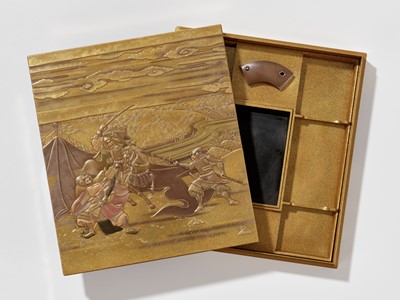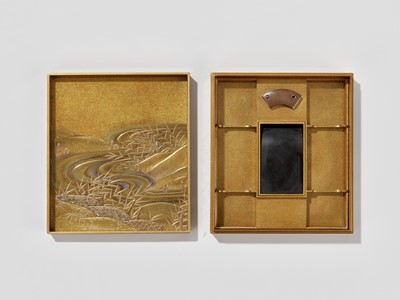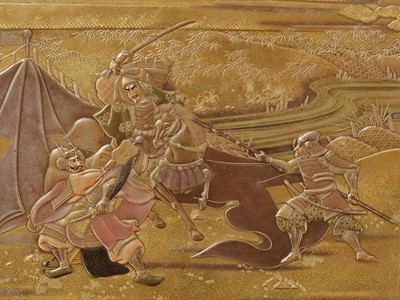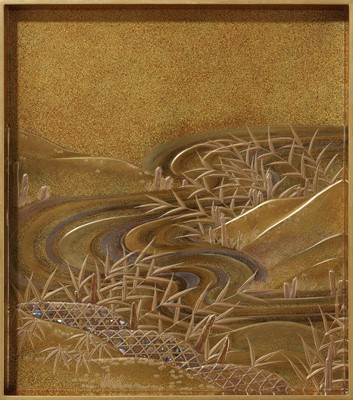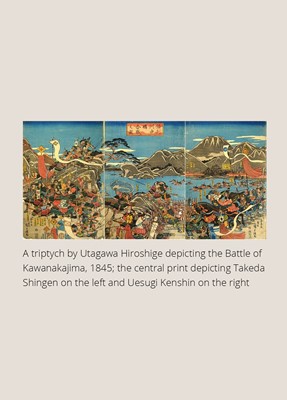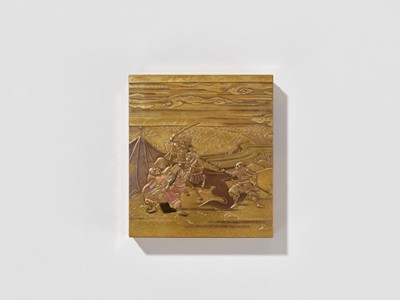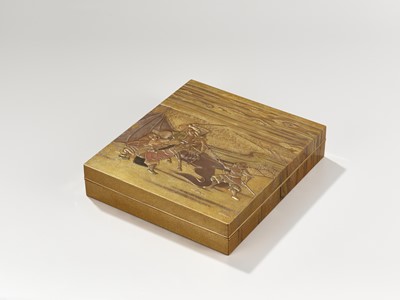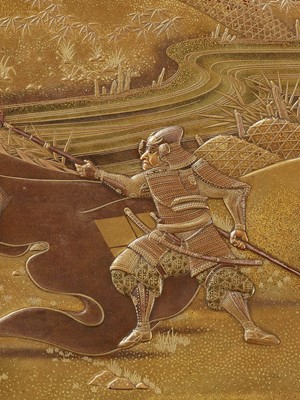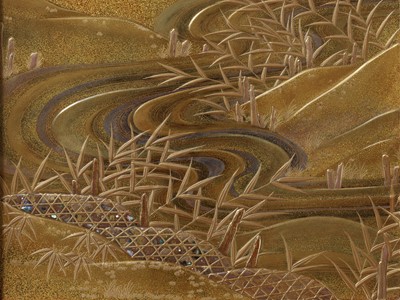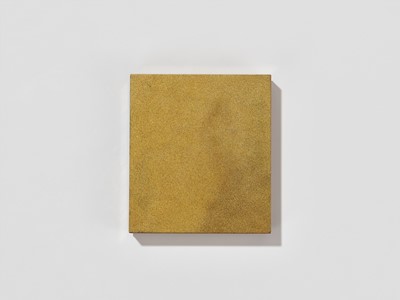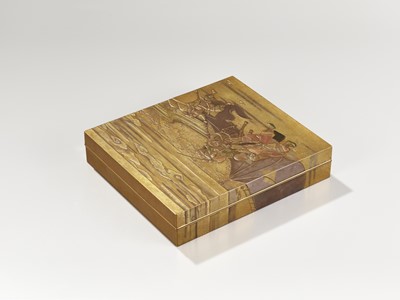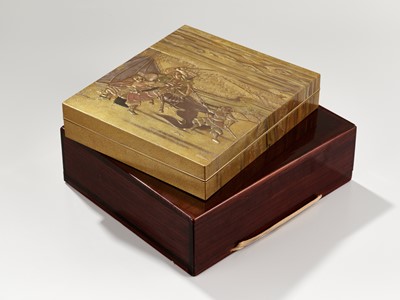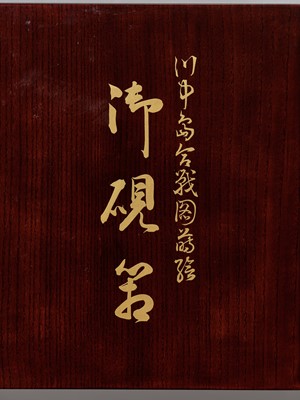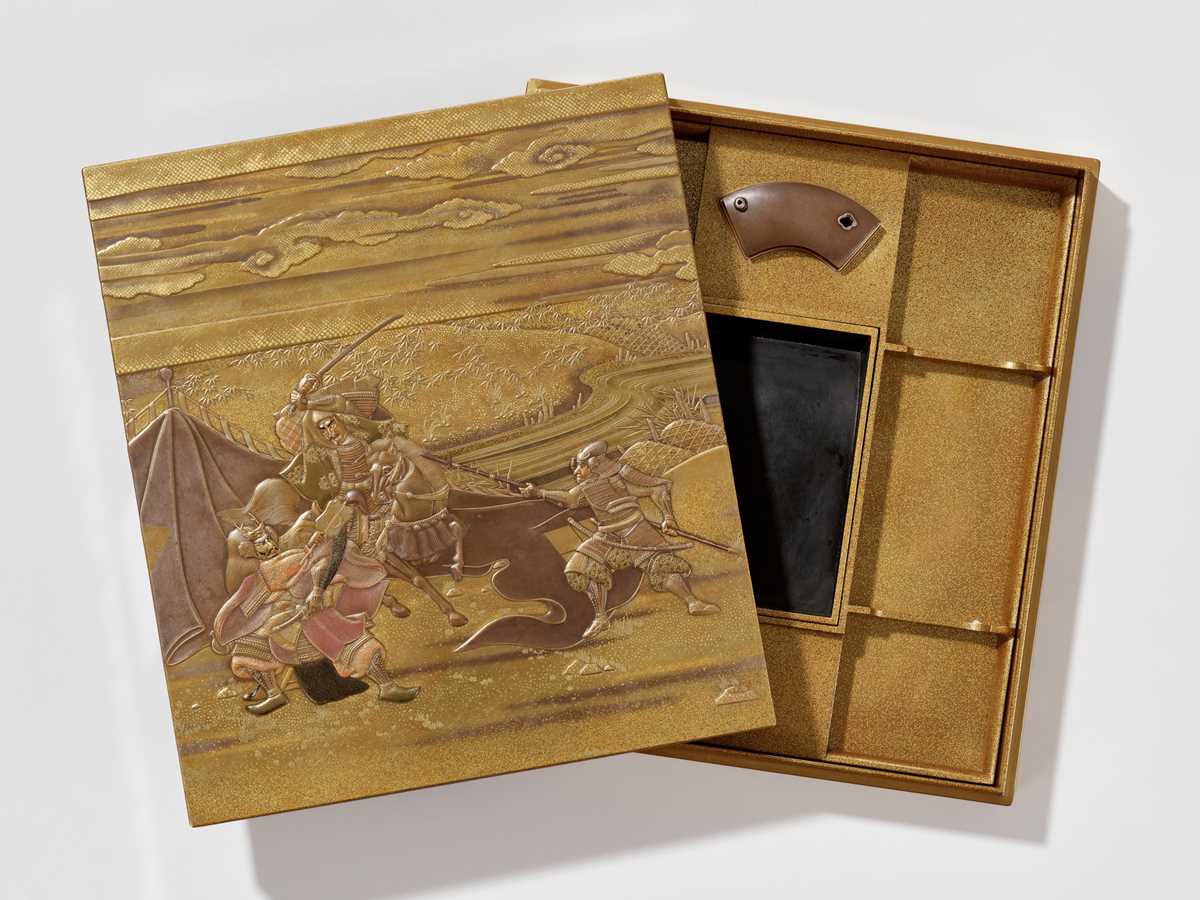16th Jun, 2023 11:00
Fine Japanese Art
36
A GOLD LACQUER SUZURIBAKO DEPICTING THE BATTLE OF KAWANAKAJIMA
Sold for €9,100
including Buyer's Premium
Japan, Meiji period (1868-1912) to Taisho period (1912-1926)
Of rectangular form, with a flush-fitting cover. The exterior bearing a kinji ground richly decorated in gold and colored hiramaki-e and takamaki-e with e-nashiji, mura-nashiji, gyobu nashiji, and kirikane to depict a fierce battle between a horse-mounted samurai on a surprise attack on an encampment, raising his katana high above his head as he is about to strike a standing warrior wearing a kabuto with an oni maedate, only able to defend himself with a fan for the moment but about to draw his own sword, while a soldier defends his master with a long yari (spear), all amid a meandering stream framed by grasses, rocks, and bamboo leaves below thick swirling clouds, continuing over to the long sides, the short sides and base of nashiji.
The interior of rich nashiji, the cover similarly decorated and with inlays of mother-of-pearl and gold foil to depict a river amid rolling hills, reeds, bamboo, and rockwork, the nine-section ita (baseboard) fitted with a rectangular inkstone (suzuri) and fan-shaped copper waterdropper (suiteki).
SIZE 5.2 x 23.1 x 26.1 cm
Condition: Excellent condition with minor wear.
With the original lacquered wood transport box with a gold-lacquered inscription 川中島合戦図蒔絵御硯箱 "Kawanakajima-gassen zu makie on-suzuribako" [Lacquer suzuribako, with the design of the Battles of Kawanakajima].
The Battles of Kawanakajima (Kawanakajima no tatakai) were a series of battles fought in the Sengoku period of Japan between Takeda Shingen of Kai Province and Uesugi Kenshin of Echigo Province from 1553 to 1564. Shingen and Kenshin contested each other for control of the plain of Kawanakajima between the Sai River and Chikuma River in northern Shinano Province, located in the present-day city of Nagano. The battles were triggered after Shingen conquered Shinano, expelling Ogasawara Nagatoki and Murakami Yoshikiyo, who subsequently turned to Kenshin for help. Five major battles of Kawanakajima occurred: Fuse in 1553, Saigawa in 1555, Uenohara in 1557, Hachimanbara in 1561, and Shiozaki in 1564. The most famous and severe battle was fought on 18 October 1561 in the heart of the Kawanakajima plain, thus being known as the Battle of Kawanakajima. The battles were ultimately inconclusive and neither Shingen or Kenshin established their control over the plain of Kawanakajima. The Battles of Kawanakajima became one of the most cherished tales in Japanese military history, the epitome of Japanese chivalry and romance, mentioned in epic literature, woodblock printing, and later in movies. They were a popular subject for woodblock prints in the Edo period, in part because both the Takeda and Uesugi clans had died out and glorification of their deeds did not therefore pose any threat to the ruling Tokugawa shogunate.
Japan, Meiji period (1868-1912) to Taisho period (1912-1926)
Of rectangular form, with a flush-fitting cover. The exterior bearing a kinji ground richly decorated in gold and colored hiramaki-e and takamaki-e with e-nashiji, mura-nashiji, gyobu nashiji, and kirikane to depict a fierce battle between a horse-mounted samurai on a surprise attack on an encampment, raising his katana high above his head as he is about to strike a standing warrior wearing a kabuto with an oni maedate, only able to defend himself with a fan for the moment but about to draw his own sword, while a soldier defends his master with a long yari (spear), all amid a meandering stream framed by grasses, rocks, and bamboo leaves below thick swirling clouds, continuing over to the long sides, the short sides and base of nashiji.
The interior of rich nashiji, the cover similarly decorated and with inlays of mother-of-pearl and gold foil to depict a river amid rolling hills, reeds, bamboo, and rockwork, the nine-section ita (baseboard) fitted with a rectangular inkstone (suzuri) and fan-shaped copper waterdropper (suiteki).
SIZE 5.2 x 23.1 x 26.1 cm
Condition: Excellent condition with minor wear.
With the original lacquered wood transport box with a gold-lacquered inscription 川中島合戦図蒔絵御硯箱 "Kawanakajima-gassen zu makie on-suzuribako" [Lacquer suzuribako, with the design of the Battles of Kawanakajima].
The Battles of Kawanakajima (Kawanakajima no tatakai) were a series of battles fought in the Sengoku period of Japan between Takeda Shingen of Kai Province and Uesugi Kenshin of Echigo Province from 1553 to 1564. Shingen and Kenshin contested each other for control of the plain of Kawanakajima between the Sai River and Chikuma River in northern Shinano Province, located in the present-day city of Nagano. The battles were triggered after Shingen conquered Shinano, expelling Ogasawara Nagatoki and Murakami Yoshikiyo, who subsequently turned to Kenshin for help. Five major battles of Kawanakajima occurred: Fuse in 1553, Saigawa in 1555, Uenohara in 1557, Hachimanbara in 1561, and Shiozaki in 1564. The most famous and severe battle was fought on 18 October 1561 in the heart of the Kawanakajima plain, thus being known as the Battle of Kawanakajima. The battles were ultimately inconclusive and neither Shingen or Kenshin established their control over the plain of Kawanakajima. The Battles of Kawanakajima became one of the most cherished tales in Japanese military history, the epitome of Japanese chivalry and romance, mentioned in epic literature, woodblock printing, and later in movies. They were a popular subject for woodblock prints in the Edo period, in part because both the Takeda and Uesugi clans had died out and glorification of their deeds did not therefore pose any threat to the ruling Tokugawa shogunate.
Zacke Live Online Bidding
Our online bidding platform makes it easier than ever to bid in our auctions! When you bid through our website, you can take advantage of our premium buyer's terms without incurring any additional online bidding surcharges.
To bid live online, you'll need to create an online account. Once your account is created and your identity is verified, you can register to bid in an auction up to 12 hours before the auction begins.
Intended Spend and Bid Limits
When you register to bid in an online auction, you will need to share your intended maximum spending budget for the auction. We will then review your intended spend and set a bid limit for you. Once you have pre-registered for a live online auction, you can see your intended spend and bid limit by going to 'Account Settings' and clicking on 'Live Bidding Registrations'.
Your bid limit will be the maximum amount you can bid during the auction. Your bid limit is for the hammer price and is not affected by the buyer’s premium and VAT. For example, if you have a bid limit of €1,000 and place two winning bids for €300 and €200, then you will only be able to bid €500 for the rest of the auction. If you try to place a bid that is higher than €500, you will not be able to do so.
Online Absentee and Telephone Bids
You can now leave absentee and telephone bids on our website!
Absentee Bidding
Once you've created an account and your identity is verified, you can leave your absentee bid directly on the lot page. We will contact you when your bids have been confirmed.
Telephone Bidding
Once you've created an account and your identity is verified, you can leave telephone bids online. We will contact you when your bids have been confirmed.
Classic Absentee and Telephone Bidding Form
You can still submit absentee and telephone bids by email or fax if you prefer. Simply fill out the Absentee Bidding/Telephone bidding form and return it to us by email at office@zacke.at or by fax at +43 (1) 532 04 52 20. You can download the PDF from our Upcoming Auctions page.
How-To Guides
How to Create Your Personal Zacke Account
How to Register to Bid on Zacke Live
How to Leave Absentee Bids Online
How to Leave Telephone Bids Online
中文版本的操作指南
创建新账号
注册Zacke Live在线直播竞拍(免平台费)
缺席投标和电话投标
Third-Party Bidding
We partner with best-in-class third-party partners to make it easy for you to bid online in the channel of your choice. Please note that if you bid with one of our third-party online partners, then there will be a live bidding surcharge on top of your final purchase price. You can find all of our fees here. Here's a full list of our third-party partners:
- 51 Bid Live
- EpaiLive
- ArtFoxLive
- Invaluable
- LiveAuctioneers
- the-saleroom
- lot-tissimo
- Drouot
Please note that we place different auctions on different platforms. For example, in general, we only place Chinese art auctions on 51 Bid Live.
Bidding in Person
You must register to bid in person and will be assigned a paddle at the auction. Please contact us at office@zacke.at or +43 (1) 532 04 52 for the latest local health and safety guidelines.
